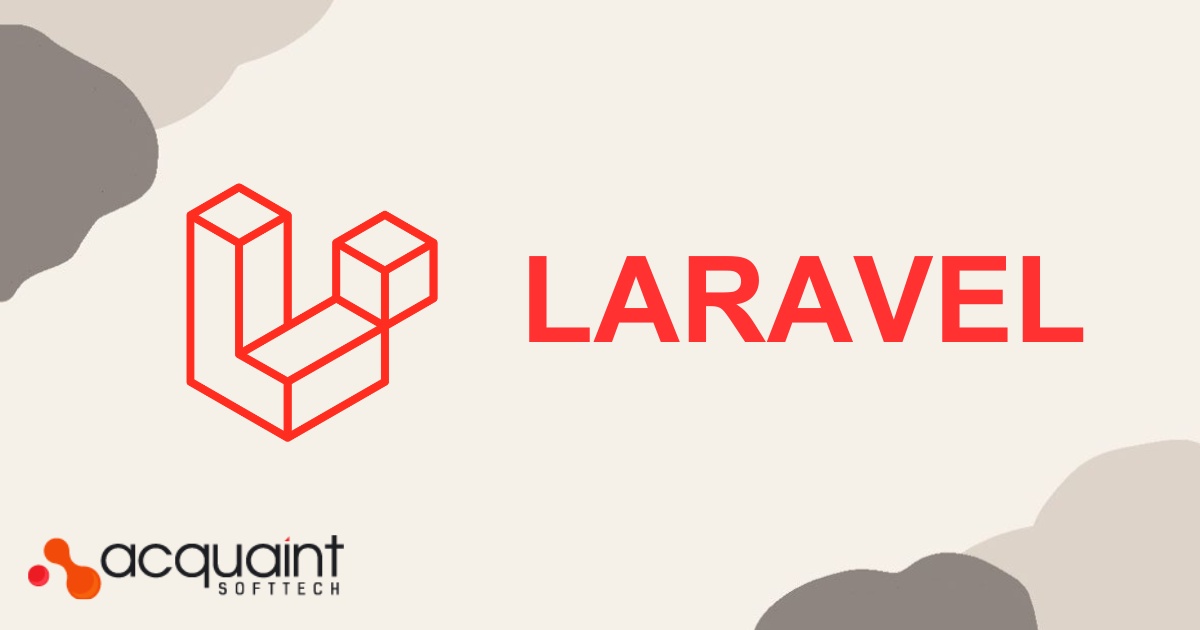Introduction
In this blog, we will explore the world of financial management software and its significance in helping individuals and businesses handle their finances efficiently. To make the process of building such software accessible to everyone, we'll be using Laravel, an incredible PHP framework known for its simplicity and versatility.
Acquaint Softtech aim is to provide a step-by-step guide that even those with little coding experience can follow. By the end, you'll have a solid understanding of how to create a robust financial management system with Laravel, empowering you to take control of your financial matters with confidence. Let's dive in!
Understanding Financial Management Software
Financial management software is a powerful tool that helps individuals and businesses manage their finances efficiently. It simplifies financial tasks and provides insights into financial health. Here are some key points to understand it better:
A. Definition and Key Features:
- Financial management software is a digital application designed to handle financial tasks such as budgeting, accounting, invoicing, and reporting.
- It offers features like expense tracking, income management, bill payments, and investment tracking.
- Many software solutions come with customizable dashboards and user-friendly interfaces for easy navigation.
B. Importance of Data Security and Accuracy:
- Data security is crucial as financial software deals with sensitive information like bank details and financial transactions.
- Strong encryption and secure authentication mechanisms ensure that data is protected from unauthorized access.
- Accuracy is vital to ensure that financial decisions are based on reliable data, preventing errors and costly mistakes.
C. Common Challenges Faced:
- Integrating with external financial services and APIs can be complex.
- Ensuring compliance with financial regulations and standards.
- Handling large volumes of financial data without compromising performance.
Understanding financial management software's features, data security, and common challenges helps users appreciate its significance in managing their finances effectively.
Getting Started with Laravel
Laravel is a fantastic PHP framework that can make building financial applications a breeze. Here's a simple guide to get you started:
A. Introduction to Laravel:
- Laravel is a popular and powerful PHP framework known for its elegant syntax and extensive features.
- It offers robust security features, making it ideal for financial software that deals with sensitive data.
- Laravel follows the MVC (Model-View-Controller) pattern, making the code structured and easy to manage.
B. Setting up the development environment:
- To begin, you'll need a local development environment with PHP and a database (e.g., MySQL) installed.
- Install Composer, a PHP dependency manager, to easily install Laravel and its components.
- With Composer ready, create a new Laravel project using the provided command-line tool.
C. Overview of Laravel's architecture and key components:
- Laravel's architecture revolves around routes, controllers, models, and views, ensuring a clear separation of concerns.
- Routes define URLs and link them to controller methods for processing user requests.
- Controllers handle user input, interact with models (database), and return data to views.
- Models represent database tables and manage data manipulation.
- Views are responsible for presenting data to users in a friendly format.
With this basic understanding, you're now ready to dive into building your robust financial application with Laravel!
Planning the Financial Management Software with Laravel
When it comes to building robust financial management software, proper planning is crucial. With the help of Laravel, a powerful PHP framework, you can create a secure and efficient application. Here's how to get started:
A. Identify Core Functionalities and Features:
- List down the essential features your financial software needs, such as expense tracking, income management, and budgeting tools.
- Analyze the target audience's requirements and preferences to ensure the software meets their needs.
B. Design the Database Schema for Financial Data:
- Plan the database structure to store financial data securely and accurately.
- Consider using Laravel's built-in migration system to manage the database schema efficiently.
C. User Roles and Permissions in Financial Applications:
- Define different user roles, such as admin, accountant, and manager, with specific access levels.
- Utilize Laravel's authentication and authorization features to control user permissions effectively.
Remember, to ensure a successful project, consider hiring experienced Laravel developers from Acquaint Softtech, a reliable Laravel development company. They can help you navigate the complexities of financial software development, making your application secure, user-friendly, and efficient.
Building the Backend
Building the Backend for your financial management software is a crucial step that requires the expertise of a Laravel development company. To ensure easy understanding for everyone, here are the key points:
A. Creating Models, Migrations, and Relationships:
- Models represent database tables, making data handling easy.
- Migrations manage database schema changes without data loss.
- Relationships define how entities interact (e.g., one-to-many, many-to-many).
B. Implementing Authentication and Authorization:
- Secure user authentication restricts access to authorized users only.
- Laravel's built-in features make implementing authentication a breeze.
- User roles and permissions control access to sensitive financial data.
C. Handling Financial Calculations and Transactions Securely:
- Accurate financial calculations are crucial for reliable results.
- Laravel provides libraries for precise calculations and conversions.
- Secure transaction handling prevents fraudulent activities and errors.
For a smooth development process, consider hire Laravel developers who are well-versed in building robust financial management software. Their expertise will ensure a secure and efficient backend for your application.
Implementing the Frontend
Implementing the Frontend for your financial management software is crucial for providing a seamless user experience. Here are the key steps to achieve it:
A. Frontend Technology Selection:
- Choose a frontend technology like Vue.js or React that complements Laravel's backend capabilities.
- Vue.js and React are popular choices known for their simplicity and performance.
B. User Interface Design:
- Focus on designing a user-friendly and intuitive interface.
- Organize the layout to allow easy access to financial features.
- Use clean and professional design elements for a trustworthy impression.
C. Integration with Backend using API endpoints:
- Collaborate with a Laravel development company or hire Laravel developers to ensure a smooth integration.
- Establish API endpoints to connect frontend requests with backend data.
- Utilize Laravel's built-in API features to handle data retrieval and manipulation.
Remember, a well-implemented frontend can enhance user satisfaction and make your financial software more attractive to users. Collaborating with experienced Hire Laravel developers will help you create a robust and user-friendly financial management software.
Ensuring Data Security and Integrity
A. Encryption: Safeguard sensitive financial data by converting it into a coded format that can only be decrypted with a secret key. Encryption prevents unauthorized access and ensures confidentiality.
B. Validation and Sanitization: Validate user inputs to ensure they meet specific criteria, such as correct data format or permissible values. Sanitize inputs to remove any harmful code that could lead to security breaches.
C. Preventing Common Vulnerabilities: Shield your software from potential attacks like SQL injection and cross-site scripting (XSS). SQL injection occurs when malicious code is injected into the application's database queries, while XSS involves inserting harmful scripts into web pages viewed by users. Use prepared statements and parameterized queries to avoid SQL injection, and sanitize outputs to prevent XSS attacks.
By implementing these security measures, you can enhance the safety of your financial management software, Acquaint Softtech can help you protecting sensitive information and providing users with a reliable and trustworthy experience.
Integrating Third-Party APIs
Integrating third-party APIs into your financial management software can enhance its functionality and provide valuable services to your users. Here's a straightforward guide to help you understand the process:
A. Exploring Common Financial APIs:
- Financial APIs are pre-built tools that allow your software to interact with external services like payment gateways and accounting systems.
- Popular financial APIs include PayPal, Stripe, Square for payments, and QuickBooks, Xero for accounting.
B. Integrating External Services:
- To integrate an API, you need to register for an API key or credentials from the provider's website.
- Use Laravel's HTTP client or existing packages to send requests and receive responses from the API.
- Process the API responses to update your application's data or trigger relevant actions.
C. Handling API Errors and Data Consistency:
- APIs can sometimes experience errors or downtime. Implement error handling to gracefully handle these situations and provide meaningful feedback to users.
- Ensure data consistency by validating API responses and cross-referencing them with your database.
- Consider implementing retries or fallback mechanisms to handle temporary API outages.
By integrating third-party APIs effectively, you can unlock powerful features for your financial software, offering a seamless and comprehensive experience to your users. Just remember to thoroughly test your API integrations and keep them up-to-date as APIs may evolve over time.
Performance Optimization
Performance optimization is crucial to ensure that your financial management software built with Laravel operates efficiently and delivers a smooth user experience. Here are some key steps you can take to optimize its performance:
A. Identifying potential performance bottlenecks:
- Conduct regular performance tests to pinpoint areas that need improvement.
- Use profiling tools to identify slow database queries, functions, or routes.
- Optimize resource-intensive operations to reduce processing time.
B. Implementing caching mechanisms for improved speed:
- Utilize Laravel's built-in caching features like Redis or Memcached to store frequently accessed data.
- Cache expensive database queries or calculations to avoid repeated processing.
- Implement HTTP caching to minimize server requests and improve response times.
C. Scaling the application for increased user load:
- Employ load balancing techniques to distribute incoming traffic across multiple servers.
- Consider horizontal scaling by adding more servers to handle increased user demands.
- Implement database sharding to partition data across multiple databases for better performance.
By taking these performance optimization measures, your financial management software will run smoothly, making your Laravel development services stand out as a top-tier Laravel development company, attracting more clients looking to hire Laravel developers.
Deploying the Financial Management Software
Deploying the Financial Management Software with Laravel is a crucial step to ensure your application is ready for real-world use. Here's a simplified guide to help you through the process:
A. Preparing the production environment
- Choose a reliable hosting provider with support for Laravel applications.
- Ensure the server meets the system requirements for Laravel.
- Set up the necessary software like PHP, Composer, and database management tools.
B. Configuring web servers and databases for optimal performance
- Use a web server like Apache or Nginx and configure it to serve your Laravel application.
- Optimize the server settings for better performance and security.
- Choose an appropriate database management system like MySQL or PostgreSQL, and configure it to work with Laravel.
C. Best practices for monitoring and error handling in production
- Implement logging to track errors and monitor application performance.
- Use tools like Laravel Telescope or third-party services for real-time monitoring.
- Set up alerts for critical issues and errors to ensure prompt action.
For a smooth deployment, consider hiring Laravel developers or a Laravel development company. They can provide expert guidance and support throughout the process, ensuring your financial management software is ready to meet the demands of your users.
Conclusion
In this blog, we've explored the world of financial management software built with Laravel, a powerful and user-friendly PHP framework. We learned about the importance of robust financial applications, ensuring data security, and accuracy. Laravel's versatility and reliability make it a perfect choice for creating such applications. Remember to plan your software carefully, prioritize data security, and thoroughly test your code before deployment. By using Laravel, you can build efficient and secure financial software that meets the needs of your users. So, dive in and start building your financial applications with Laravel today!


No comments yet